
EV3 Research
@EV3Research
Followers
342
Following
16
Media
1
Statuses
27
Blockchain research arm of @EV3Ventures focused on highlighting advancements in cryptography and DePIN networks.
Joined June 2024
7/Dive into Superbuilders in our latest piece ⬇️ .
paragraph.com
In a world where blockspace is abundant, composability is what matters. Superbuilders, like NodeKit's Javelin, guarantee atomic execution of transactions across rollups, solving the root problem and...
0
1
2
6/ Superbuilders also enable MEV capture across chains, estimated to be worth $3.6B by @flashbotsmev as well as allow apps to access liquidity from all chains in the network and giving consumers the ability to keep their funds on one chain.
1
1
3
6/ The good news? Innovation is underway. Learn more about this technology and its implications in a recent Coindesk article written by our team!⬇️. .
coindesk.com
AI is at risk of the same centralization seen in earlier editions of the internet. But another way is possible, say Mahesh Ramakrishnan and Vinayak Kurup.
0
0
1
4/ 👀 Teams like @gensynai and @InferenceLabs are working to deploy decentralized training and inference using consumer hardware. The challenge? Tough engineering problems, like the floating point problem.
1
0
1


